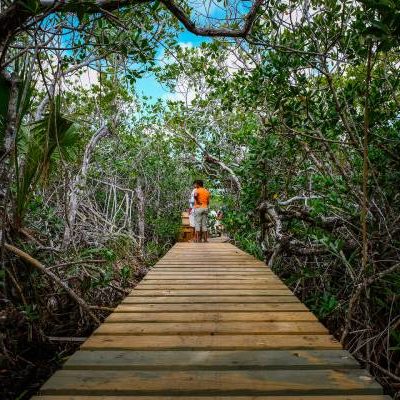Lucayan National Park
est. 1982
About
The Lucayan National Park protects one of the world’s longest charted underwater cave systems, preserved remains of the Lucayan Indians, and a prime combination of natural environments including pine forests, mangroves creeks, coral reefs, and the world-famous Gold Rock Beach. This Park exhibits all of the Bahamian vegetative zones. Established in 1982 and expanded in 2015, this national park is an important part of the economy of Grand Bahama supporting the livelihoods of many Bahamians. Lucayan National Park is now the 2nd most visited national park in The Bahamas.

Beach
This park has beach access.

Boardwalks and Trails
There are access boardwalks and trails in this park.

Bird Hotspot
This park has high bird activity.

IBA
This park is internationally recognized as an Important Bird Area.

Popular Attraction
This park is a popular tourist attraction.

Restrooms
This park has restroom facilities available.

Visitor’s Center
This park has a visitor’s center.

Warden
This park has an active warden.
Admission
(VAT Inclusive)
$12 per adult | $6 for kids 12 & under
Seniors (60+ yrs.) – $9
BNT Members – FREE
BNT tour guides are available only by arrangement
Park Hours
Sat & Sun: 9am to 4pm
THE JEWEL OF GRAND BAHAMA.
The Lucayan National Park conserves a superlative amount of biodiversity. All Bahamian terrestrial vegetative zones are represented in the park. The 2 caves protect ancient remains and also are home to many unique species of cave dwellers.
In the late 1970s, an exploring biologist scuba diving in Ben’s cave collected an unusual centipede-like organism and further studies revealed that the tiny opaque animal was not only a new species (Speleonectes lucayensis) but also a previously unknown class of crustacean which was given the name Rempedia (“oar foot”). Specially adapted to a dark, underwater environment, the blind Remipedes had existed in Grand Bahama caves for millions of years.
The Park encompasses a portion of Gold Rock Creek which connects with the ocean approximately 2 miles east to the ocean. This mangrove tidal creek is the last intact on the southern shores of Grand Bahama. It supports a productive mangrove ecosystem and from the boardwalk one may observe saltwater fishes, wading birds, and waterfowl among the large stilt-like roots.

Last Resting Place
In 1986 archaeologists discovered the skeletal remains of six indigenous Lucayans on the floor of one cave as well as artifacts in other areas of the Park. One of the remains were sent to the Smithsonian Institute in Washington DC, where they were carbon dated and confirmed to be from the Lucayan era. These remains are definite evidence of pre-Columbian settlement on Grand Bahama. The Lucayan National Park is named after these original inhabitants of The Bahamas. The Lucayans used the caves as a source of freshwater and as ceremonial burial places. Due to the low oxygen level found in caves, archeological remains are well preserved and have been found in some cave sites, including Burial Mound. The freshwater reservoirs found in the caves and blue holes are still highly important for island residents today.
Ben’s Cave and Burial Mound Cave, are also the entrance to one of the largest underwater cave systems in the world, with over 6 miles of tunnels charted. Stairs lead from the sinkhole lip to viewing platforms just above the water level. The cool dark recesses of the cavern provide shelter and nursery sites for migratory bats in the summer.
Ben’s Cave holds 60 ft of water with the top 30 feet representing the freshwater table over 30 feet of saltwater, with a mixing zone (halocline) in between. Saltwater grey snappers are regularly seen swimming in the top freshwater zone which shows that over time these fish have adapted to this environment. The grey snappers also travel back and forth between Ben’s Cave and Gold Rock Creek through numerous submerged tunnels.


Gold Rock Beach
Gold Rock beach is known as “The Welcome Mat of Grand Bahama”. There is a healthy reef system offshore, a result of both the undeveloped state of the area and the positive effect of the Gold Rock Creek Mangrove nursery which provides grazers such as parrotfish which clean the algae off of the reefs. In 2018, Gold Rock Beach was voted as the best beach in The Caribbean by USA Today.
Through a partnership with the Freeport Harbour Company, a coral Nursery has been established offshore south east of Gold Rock with the capacity to grow 250 elkhorn and staghorn corals at a time.
HISTORY
A Grand Bahamian Treasure.
In July 1981, a commercial diving organization became interested in leasing the land around the entrance to Ben’s Cave so that they might have exclusive use of the cave for their private purposes. It was at this point that the Executive Director of the Trust at that time, Mr. Rod Attrill, wrote to the Grand Bahama Port Authority to request that they consider placing this area under the care of the BNT. Mr. Attrill argued that the cave system represented an important part of both the natural and historic heritage of the Bahamas. “Not only is this area a beautiful example of natural erosion and cave formation, but several Lucayan graves were also found in the vicinity.’

Ben’s Cave | Lucayan National Park
Following an Executive Committee meeting, Mr. Basil Kelly, Executive Committee Chairman, wrote to the president of the Grand Bahama Port Authority, expressing the Trust’s concern for the welfare of this area. There was expressed concern for the removal of stalactites and stalagmites and the shooting of bats for no reason. New forms of life were also being continually discovered in the cave. During the latter part of 1981, many scientists who were doing research in The Bahamas also expressed concern for the Lucayan Caverns. They felt that inexperienced divers were entering the caves and that the presence of divers in the caves was resulting in the death of much of the algae, thereby upsetting the delicate ecosystem.
In March 1982, the Bahamas National Trust signed a 99-year lease with the Grand Bahama Development Company, giving it in a portion of land situated west of Mole Hope and east of Mangrove Point on the southern coast of Grand Bahama as well as the caves located beneath this property. Shortly following the signing of this lease in March 1983, it was decided that the Lucayan National Park would be closed to all, except scientists and qualified divers who received permission from the BNT. This was done to allow the area to recover from the impact of man. The Lucayan National Park was reopened to the public in 1985.

Operation Raleigh Participants | Constructing boardwalks through LNP.
Initial development of the park came from some fortunate circumstances: Operation Raleigh, a multi-national Peace Corps under the patronage of Prince Charles, inquired if there were any projects for a youth group to tackle on the island. A site plan was developed including a figure eight pathway and boardwalk system, a location for a footbridge over the Creek and a sketch design for a Visitor Centre. In just a few weeks, with lots of materials donated by the community, the pathways were cut and work commenced on the bridge crossing Gold Rock Creek.
COMING SOON:
Stories About Lucayan


